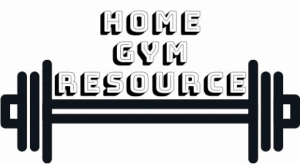Weight plates are available in a confusing amount of shapes, types, materials, and designs, each serving specific purposes in the world of strength training. Whether you’re a seasoned lifter or just starting your fitness journey, understanding the different types of weight plates and their uses can help you make informed choices when it comes to your workout equipment.
In this article, we’ll explore a wide range of weight plate options, from traditional to specialized, and delve into what each type is for. At the bottom, you can find which type of plate you should get for which purpose.
Contents
- 1 Types Of Weight Plates
- 2 Tip
- 2.1 1. Cast Iron Weight Plates
- 2.2 2. Bumper Plates
- 2.3 3. Rubber-Coated Plates
- 2.4 4. Olympic Weight Plates
- 2.5 5. Standard Weight Plates
- 2.6 6. Change Plates
- 2.7 7. Fractional Weight Plates
- 2.8 8. Grip Plates
- 2.9 9. Color-Coded Weight Plates
- 2.10 10. Calibrated Weight Plates
- 2.11 11. Competition Weight Plates
- 2.12 12. Deep Dish Weight Plates
- 2.13 13. Cement/Sand-Filled Weight Plates
- 3 What’s The Best Type of Plate For a Home Gym?
- 4 Tip
Types Of Weight Plates
Below you can find a list of the most common types of weight plates.
There is a lot of overlap within these types. Some of these types are more like features but they’re sold as a specific type of plate. For example, a rubber-coated plate has a cast iron core and can also have grip handles. We’re spanning three types right there.
This is not an exhaustive list, there are some very specific types of weight plates you can find that are not on this list. Most of those are not general types, just names a certain brand has given their plates that are just a bit different. It would be too confusing to list all those here.
Summary
Here’s a quick summary of all the types. We’ll go into depth on all of these below.
| Type of Weight Plate | Purpose | For Who? |
|---|---|---|
| Cast Iron Weight Plates | Classic choice for strength training. | Home gym owners who want affordable but durable plates. |
| Bumper Plates | Designed for Olympic weightlifting. | People who drop weights from overhead. |
| Rubber-Coated Plates | Protects against floor damage and noise. | An upgrade over bare cast iron plates that reduce damage and noise but cost more. A great choice for home gyms. |
| Olympic Weight Plates | Plates with a 2″/50 mm diameter hole that fit on Olympic bars. | The right choice for all gym builders. These can be cast iron, coated or bumper plates. |
| Standard Weight Plates | Plates with a 1″/25 mm diameter hole that fit on standard bars. | Avoid if possible |
| Change Plates | 1.25, 2.5, and 5-pound plates. | For use in conjunction with bumper plates. |
| Fractional Weight Plates | Fine-tuning for incremental increases. | For people who need smaller increments than 2.5 pounds. |
| Grip Plates | Convenient handles for carrying and loading. | If you’re buying cast iron or rubber-coated plates, opt for the ones with grip holes. |
| Color-Coded Weight Plates | Simplify identification and loading. | Good for easy recognition. Not necessary in most cases. |
| Calibrated Weight Plates | Precision-engineered for competitive lifting. | For people who need their plates to weigh exactly what’s on them. For (semi)professional lifter. |
| Competition Weight Plates | Designed for powerlifting and weightlifting competitions. | For official competitions. |
| Deep Dish Weight Plates | Classic design with a wide rim. | People looking for stronger and more accurate cast iron plates or prefer the look. |
| Cement/Sand-Filled Weight Plates | Budget-friendly but low-quality plates that should be avoided. | Avoid if possible. |
Tip
1. Cast Iron Weight Plates
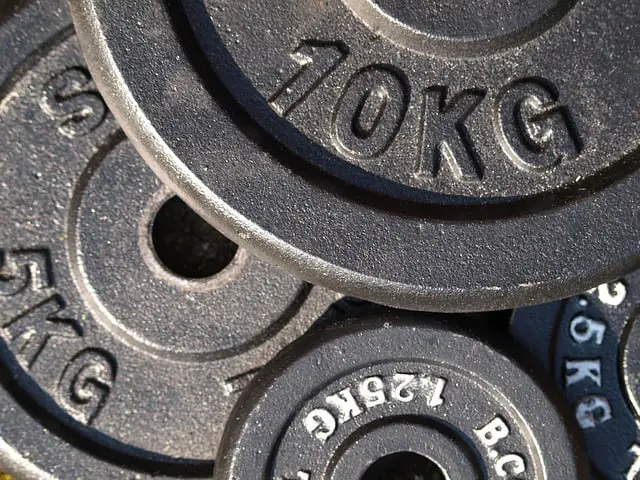
Description: Cast iron weight plates are the classic choice for strength training. They are typically round but can also be hexagonal with a central hole for barbell or dumbbell insertion and have a solid, dense construction.
Usually, the outside of these plates is coated in Hammertone or another type of paint to prevent corrosion. Because they are hard on the outside, using these plates can be quite noisy.
These plates come in standard (25mm/1″) and Olympic (50mm/2″) variations. The only difference is the size of the inner hole.
Uses: Cast iron weight plates are the classic choice for strength training. They are highly durable and provide a consistent weight. These plates are excellent for most barbell exercises and plate-loaded machines.
2. Bumper Plates
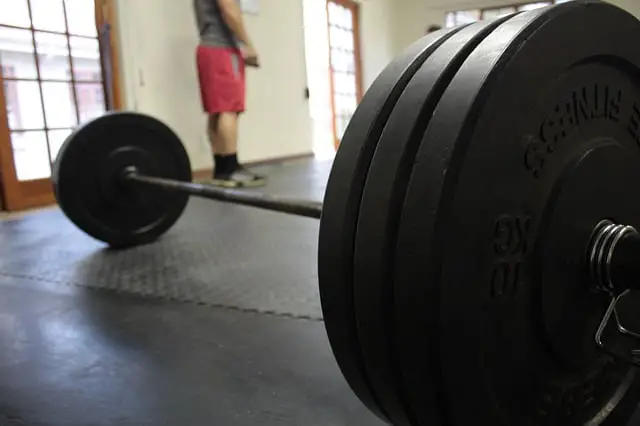
Description: Bumper plates are designed for Olympic weightlifting and CrossFit. They completely are made from rubber or urethane. (These are different from rubber-coated plates.) The benefit of this construction is that they can be dropped from overhead many times without breaking or cracking, unlike cast iron plates.
Bumper plates are always Olympic plates with 2″ diameter holes to fit on Olympic barbells. Their diameter stays the same for all the different weights but the thickness of the plates differs. For example, a 45-pound bumper plate is usually about 2.5″ wide while a 10-pound plate is about 0.8″-1″ wide.
Uses: Bumper plates are designed for Olympic weightlifting and CrossFit. They are made from rubber instead of steel. this protects both the plate and the floor when dropped. This makes them ideal for high-impact movements like snatches and clean and jerks.
If you don’t drop your weights, these plates don’t have much added value.
3. Rubber-Coated Plates
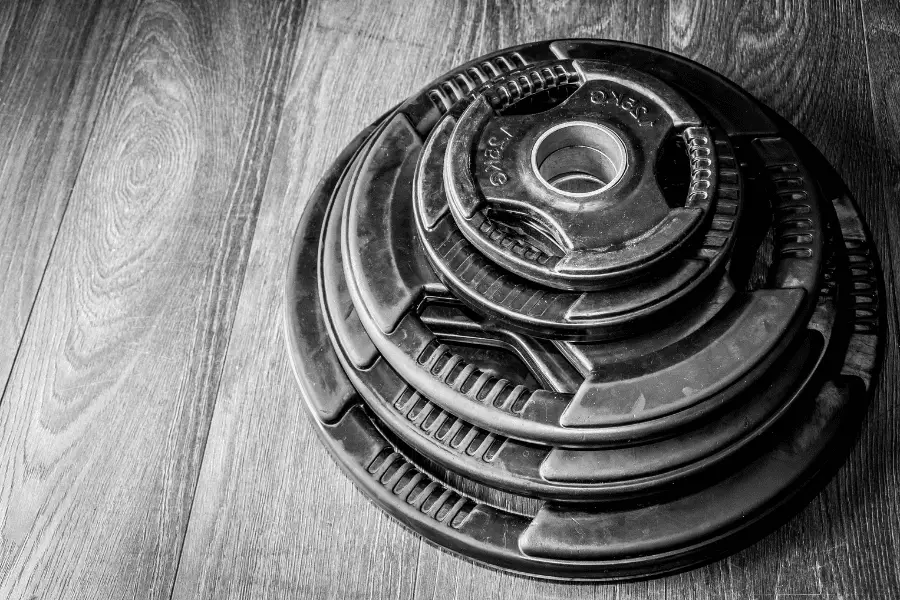
Description: Rubber-coated plates have a cast iron or steel core with a rubber or urethane outer layer for added protection and noise reduction. These are different from bumper plates and the outer layer doesn’t mean you can drop these from overhead.
The rubber casing helps reduce noise, protects the plate and your floor from damage, and are more comfortable to handle. They cost more than bare cast iron which makes them a premium pick for your home gym. Most commercial gyms will use this type of plate.
Uses: Rubber-coated plates provide protection against floor damage and reduce noise during lifts. They are a great choice for commercial gyms and home setups where noise and floor protection are a concern.
4. Olympic Weight Plates
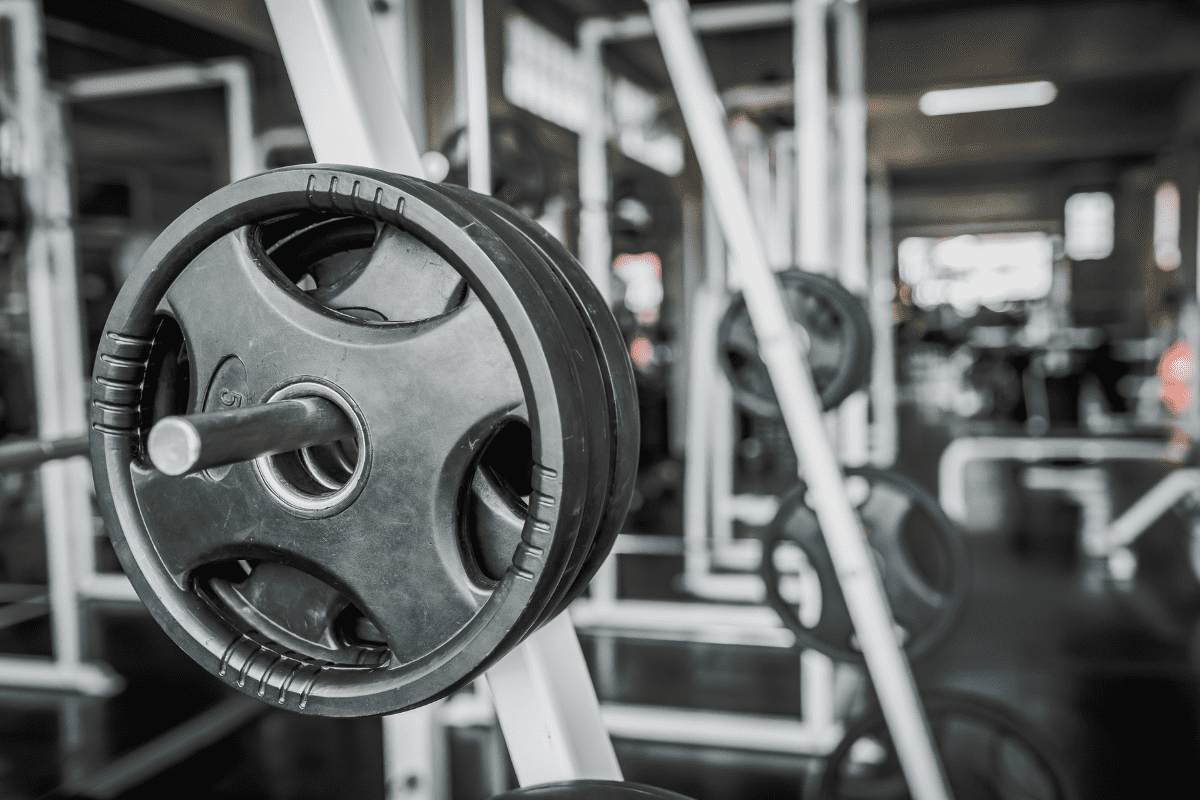
Description: Olympic weight plates aren’t necessarily the type of plate used during official competitions. The distinctive feature of Olympic weight plates is that they fit on Olympic-sized barbells, featuring a 2-inch hole.
Cast iron, rubberized and bumper plates can all be Olympic plates (most of them are). So don’t think you can drop these plates just because they say “Olympic”. You’ll still need to buy specific bumper plates for that.
Uses: Olympic weight plates are the standard for competitive weightlifting. They come in varying weights and are used with Olympic-sized barbells. These are the best choice for all home, garage, and commercial gyms for several reasons.
5. Standard Weight Plates
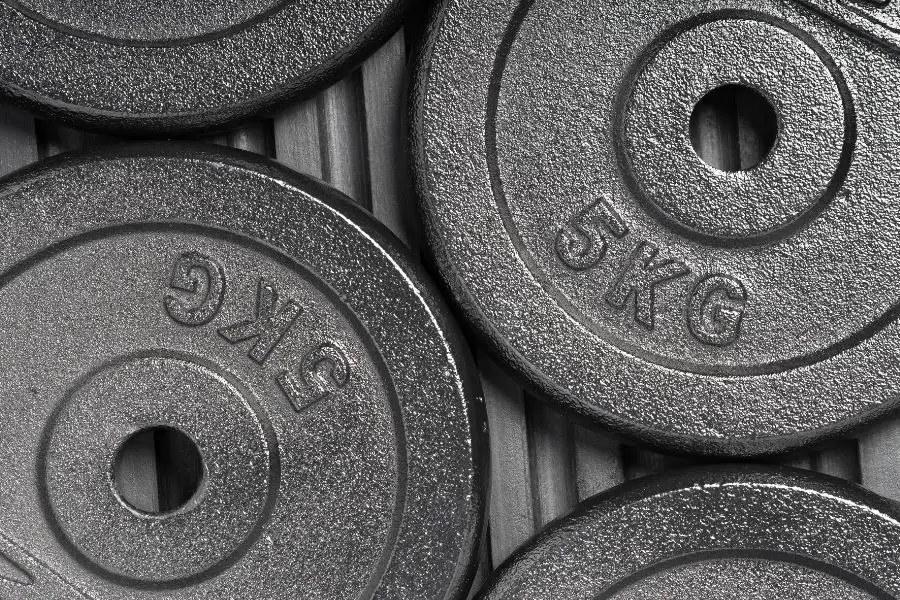
Description: Standard weight plates have a 1-inch diameter hole as opposed to the 2″ hole of Olympic plates. They fit on different equipment and barbells. These used to be the standard gym plates a long time ago but have now been superseded by Olympic plates because of their benefits.
These plates are still seen in home and garage gym setups, especially the older ones. If you’re buying new, always go for Olympic plates and barbells.
One piece of equipment that still often uses 1″ standard plates is the plate-loaded dumbbell.
Uses: Standard weight plates are OK for home gym setups but if you have the option, buy Olympic plates instead.
6. Change Plates
Description: Change plates are lighter plates to be combined with bumper plates. Bumper plates usually only go down to 10 pounds. And a 20-pound jump in weight is too much. Change plates are smaller (metal) plates that weigh 1.25, 2.5, and 5 pounds.
They are a smaller diameter than the normal bumper plates because they
Usually, change plates are just rubber-coated metal plates but they look like tiny bumper plates. In competition settings, they are color-coded so it’s easy to recognize the weight.
Use: Change plates are made to be used in conjunction with bumper plates since bumper plates have weight jumps that are too big.
7. Fractional Weight Plates
Description: Fractional weight plates, also known as “micro load” plates are small, precision-weighted discs used for fine-tuning your lifts. They are very similar to change plates, just lighter. Where change plates are used in competition, fractional plates are just for training. They are available in 0.25, 0.5, 0.75 and 1 pound. Usually, they’ll come as a set.
These are used when even a 2.5-pound jump in weight (2×1.25) is too much. This can happen if you’re really at the limit of your capability. However, maybe you can still lift 0.5 pounds more and get a little bit stronger. That’s where fractional plates are useful.
Uses: Fractional weight plates are tiny but mighty. They allow for incremental increases in weight, perfect for progressive overload. These plates are indispensable for fine-tuning your strength gains.
8. Grip Plates
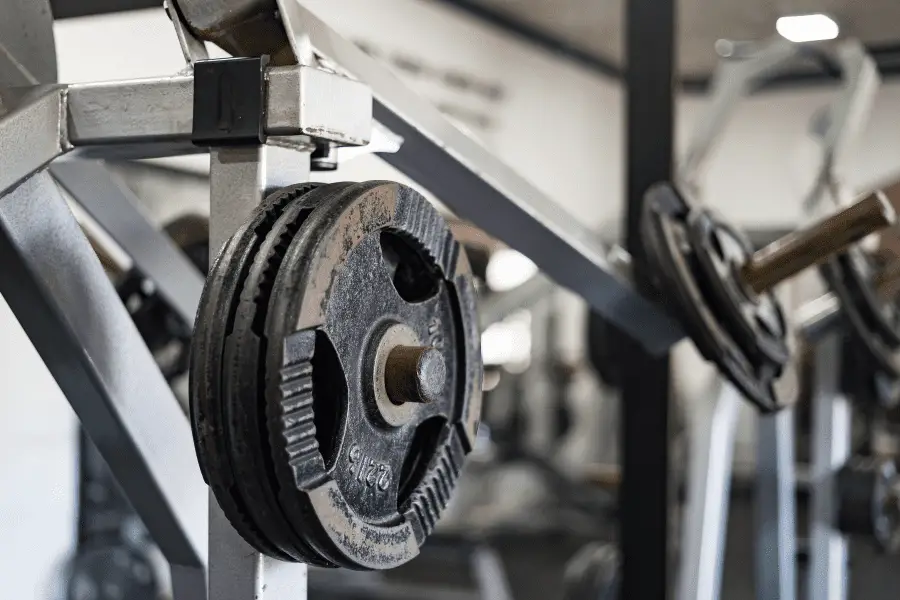
Description: Grip plates feature handles (usually holes with rounded edges), making them easy to carry and load onto bars. These are always iron plates but they can be bare cast iron or rubber coated. Bumper plates never have grip holes.
Also, you’ll usually only see grip holes on heavier plates. On small plates having extra holes isn’t practical.
It’s advisable to buy plates with this feature since it makes handling the plates much easier.
9. Color-Coded Weight Plates
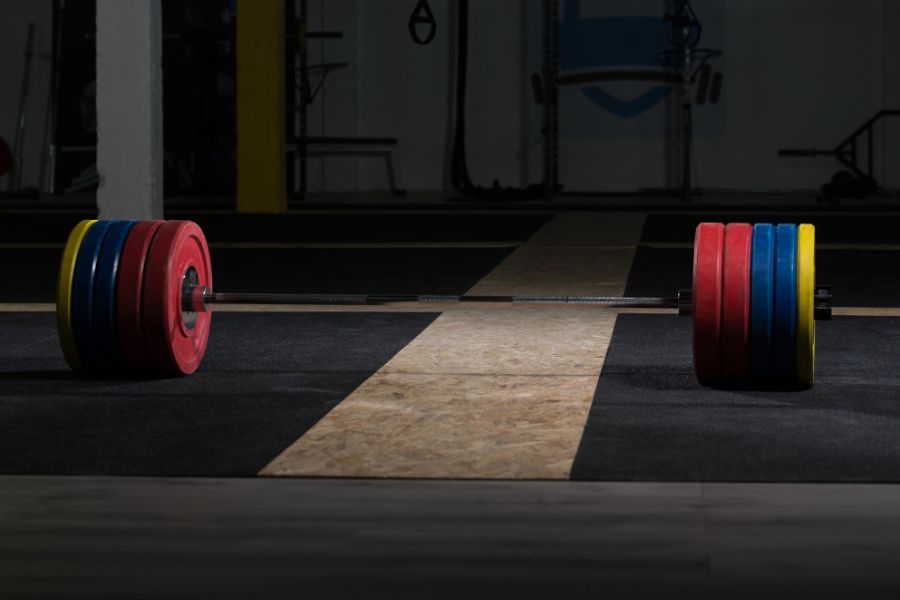
Description: Color-coded weight plates have different colors corresponding to specific weights for easy identification. Color-coded plates are almost always bumper plates. These are used in competitions to make it easy to see how much you’re lifting. It’s also harder to make mistakes loading the bar with these.
Uses: Color-coded weight plates simplify identification and loading during workouts and competitions. Each color corresponds to a specific weight, streamlining the setup process and reducing confusion.
10. Calibrated Weight Plates
Description: Calibrated weight plates are precision-engineered to meet exact weight specifications and are used in professional powerlifting competitions. Normal, non-calibrated plates usually have weight differences of about 5% or sometimes more. Usually, the cheaper the plates, the bigger the differences.
During normal training, this isn’t a huge deal but if you’re training for an official competition, it can make a difference. If you think you can lift 300 pounds but all the weight plates during training are 5% lighter, you might not get the lift and lose the competition.
In a home or garage gym where you’re more focused on increasing the resistance and building muscle than the total weight, these discrepancies don’t matter much. But if getting the exact numbers is important, it’s definitely worth getting calibrated plates.
Uses: Calibrated weight plates are precision-engineered to meet exact weight specifications. They are used in professional powerlifting competitions to ensure uniformity and accuracy.
11. Competition Weight Plates
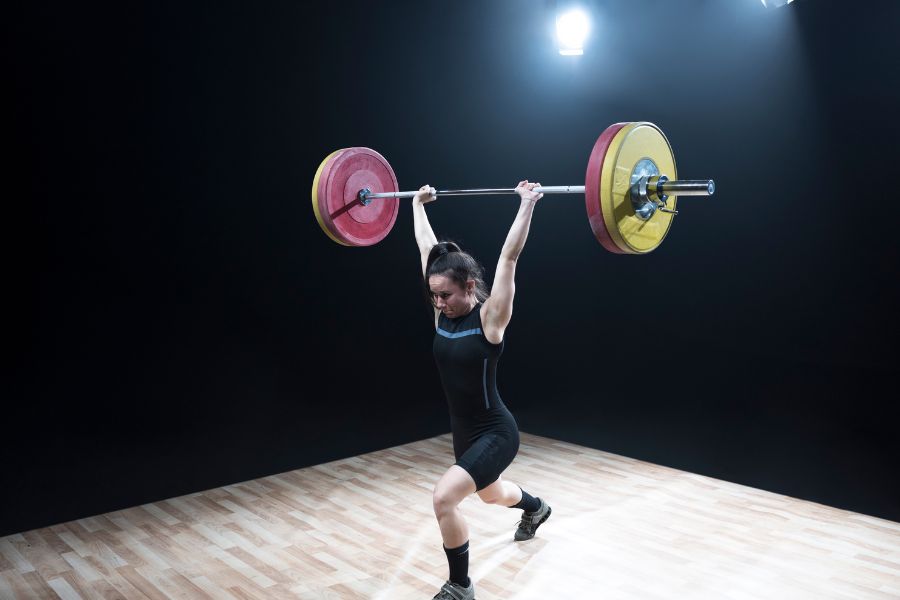
Description: Competition weight plates are specially designed for use in powerlifting and weightlifting competitions. This is the next step up from calibrated plates. Competition plates are calibrated and certified by the governing body of the relevant weightlifting competition.
The IPF and IWF have their own standards for equipment. The plate dimensions, materials, and weights have to be within the allowed specifications set by the organization to be certified. Those specifications are very tight, usually within 0.1% or smaller.
For home use, even if you need the plates to be precise, these aren’t necessary. Calibrated plates will be fine.
Uses: Competition weight plates are designed for use in powerlifting and weightlifting competitions. They meet strict international standards to ensure fair and consistent performance on the competition platform.
12. Deep Dish Weight Plates
Description: Deep dish weight plates are the very classic weight plates. They have a rim at the edge that’s wider than the rest of the plate. Usually, the rim around the inner hole is also thicker for strength.
One benefit of the deep dish plates’ wide rim is that there is more surface area where the plates touch the floor. That means the pressure on impact is less and the drop is less likely to damage the floor or the plate itself. This construction also gives them more strength and durability than other cast iron plates.
Another benefit is that these plates are usually more weight accurate than other cast iron plates but they often cost more as well.
And finally, these have that classic look that many people find appealing.
However, these are not for Olympic lifting. I’d recommend getting bumper plates for that purpose.
13. Cement/Sand-Filled Weight Plates
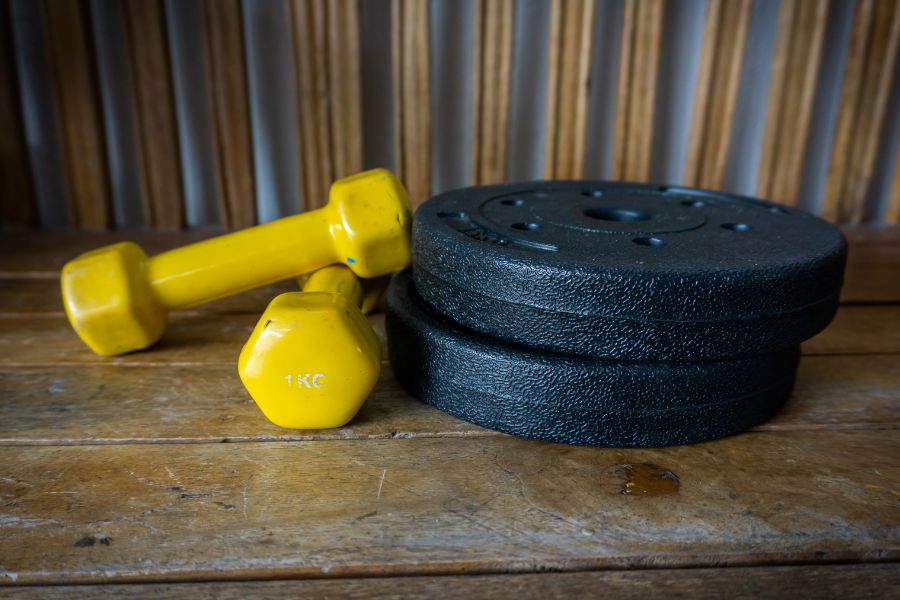
Description: Sand-filled weight plates are a budget-friendly option, with a cement or plastic shell filled with sand. Sand and cement are a lot cheaper than steel or rubber which is why these are cheap.
They’re also not very good. They break easily and then you’ll have a mess on your hands. They’re often not built well so they don’t feel good in your hands and as a cherry on top, these are known to be very weight inaccurate.
If you have them lying around, use them until they break or you want to upgrade. However, if you’re buying new, there are budget cast iron plates that are much better.
What’s The Best Type of Plate For a Home Gym?
Tip
Are you even more confused than before about what plates you need for your home or garage gym? Here are the best options for the three most common situations:
Best type of weight plate on a budget: Olympic Cast Iron Grip Plates
You want to build a durable home or garage gym but don’t want to break the bank.
Olympic cast iron plates with grip holes are your best choice. These are widely available, are cheap, and will last a long time. These plates last for decades as long as you protect them from moisture (rust) and don’t drop them from up high.
Best overall weight plate: Olympic Rubber-Coated Grip Plates
You want good general-purpose home gym plates and have a bit more money to spend. The noise and potential damage from bare cast iron plates don’t sound that good.
the best choice here is rubber-encased plates. You get the durability of cast iron plates but with a softer, more comfortable exterior. They cost a bit more but they’re well worth it for the extra comfort. Most of these plates will have grip holes but make sure before you buy.
Best weight plate for Olympic lifting/Crossfit: Bumper Plates
If you drop the bar often from chest height or higher, you need bumper plates. Cast iron or rubber-encased plates can’t handle those drops.
In addition to bumper plates, you’ll need a set of change plates since the lightest bumpers weigh 10 pounds. that means you have to add at least 20 pounds to the bar every time and that’s just too much.
